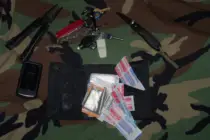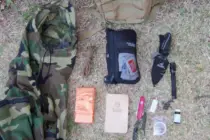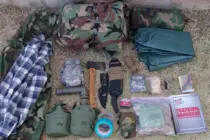One of the more popular ideas for survival gear organization is the “Three Tier Survival Gear Kit”, also known as Modular Survival Kit. This extra organization for your Bug Out Bag and EDC will help you to survive almost any situation that you encounter.
Let’s talk about modular survival kits. Once you see the advantages of organizing modularity you won’t go back to throwing all of your gear into a pocket and hoping that you have not forgotten anything, but before we get into that, let’s look at what modular means.
“mod·u·lar” – adjective – composed of standardized units or sections for easy construction or flexible arrangement: a modular home; a modular sofa, involving modules: made up of separate modules that can be rearranged, replaced, combined, or interchanged easily.
So with that understood, lets get under way.
SKIP AHEAD
First “Tier”
My basic survival gear is divided up into three “Tiers”, 1st Tier is the stuff that is always in my 
Its purpose is to get me through the day-to-day routine, but it is also my fallback or bomb burst kit. If I were to be stranded somewhere with nothing else except for what I have on my person, then this Tier 1 Survival Gear Kit is what I would have to survive with. I keep my Tier 1 gear divided up in three locations on my person, wallet, key chain, pockets and belt.
Wallet
Fire Starter
I keep a small fire steel, a book of waterproof matches and waxed fire-starter in a small zip lock bag in my wallet for making fires in an emergency.
Signaling
A small signal mirror can be effective if the time is taken to learn how to use it properly.
First Aid
A couple of band-aids, a razor blade, and an antiseptic pad pack flat but can be very useful.
Phone Card
An economical substitution to the classic roll of quarters for emergency, non-cell phone, phone calls.
US Dollars
I keep a small amount of US Dollars stashed in the zip lock bag as well ($85.00 – 3 x$20’s, 2x$10’s, and 1x$5) and will only use it as a last resort.
I keep a minimal amount of gear in my wallet to keep the size down but if you want info on a freestanding urban survival wallet kit check out this link.
Key Chain
Cordage
Cordage is an important part of survival. It’s used for bowstrings, lashings, fishing line, snares, tying down shelters and more. I carry about 6 feet of military 550 paracord in the form of a key-chain fob.
One of the benefits of paracord is that not only is it strong (it has a 550 lbs. rating – thus the name), but it is made up of a strong outer sheath and seven inner strands that can be used for multiple purposes. Just carrying 6 feet of paracord is like carrying 48 feet of cordage! Another great way to carry a lot of cordage is to make a paracord bracelet, check out this site for great paracord craft ideas.
Pinch Light
These small pinch lights provide enough light for limited travel and nighttime camp activities (building a fire, setting up camp, bathroom trips, etc.), and the LED versions last forever.
Fire Starter
Redundancy is the key to a good kit, another small fire striker takes up very little space.
Pocket Knife
A small Swiss Army Knife will go unnoticed in most environments, although be careful, in our “Politically Correct” society even a small knife is not allowed in public places like schools, and courthouses.
Whistle
A small flat whistle is way better than shouting when you need to attract attention.
Compass
Commonly known as a button compass or a that-a-way compass, they may not be that accurate but they are sure better than nothing.
(Note: This is my EDC key chain which I keep on a carbiner clip attached to my belt loop. I also have a separate key ring for hiking which is a bit more comprehensive)
Pants Pockets and Belt

Pocket Knife
A full size lock-back pocket knife (Spyderco Manix) with a good clip and the ability to be opened one handed is an essential piece of gear for utility and last ditch defense. Same cautions apply to this as the pocket knife on the key chain.
Cell Phone
In this modern age while it may not be a survival item it is a nice convenience.
Wallet
As above explained
It depends on if I am expecting to be out after dark whether or not I will carry a Mini-Maglight or similar flashlight.
Multi Tool
Another item that may be left at home depending on the amount of weight I am willing to carry is a Leatherman Or Gerber multi-tool which is an extremely nice piece of equipment for utility use.
What I Can Do With It
By carrying my first “tier” kit I have the means to obtain or improvise food, shelter, and water, I can signal, I have a means of security, and I can administer some limited first-aid.
Second “Tier”
The second-tier survival kit includes items that you can fit in a small carry bag (like a fanny 
Fixed Blade Knife
A heavy duty Survival Knife like a Spyderco Bushcraft, or on the cheaper end of the scale something like the Gerber Profile. Something that can serve in a defensive role as well as performing heavy utility duties such as baton cutting wood.
Full-Size Compass
Even though I already have one on my first tier, I like to upgrade to a full-size compass for ease of reading an azimuth.
Water Container
I house my second tier kit in a Camelback, but if internal reservoirs aren’t your thing consider using something like Nalgene or similar.
Fire Starter
Again, for redundancy’s sakes I have a duplicate to what is in my first tier in addition to a water/ wind proof lighter, and a small fire-starting brick.
Water Purification Kit
In a small kit like this, water purification tablets work great.
Flashlight
On my budget I carry a souped-up Mag-light, although I prefer a SureFire G2.
First-Aid Kit
This is smaller than what I carry in my third-tier kit, but includes Tweezers, Gorilla tape, 1″ adhesive tape, Ibuprofen, various sizes of band-aids, Butterfly closures, moleskin alcohol pads, triple antibiotic ointment Hydro-cortisone cream and a lot more.
Simple Shelter
I carry an emergency blanket and sometimes a lightweight tube tent for space’s sake.
Cordage
About fifty feet of para-cord in ten foot lengths.
Signal Mirror
Just a standard signal mirror that has a hole in the center for accurately aiming the reflected light.
Multi-Tool
Usually a copy of what I carry in my first “tier” kit or a Swiss Army Knife.
Rain Gear
A military issue Gore-tex raincoat for when I am expecting rain, otherwise just a Wal-Mart poncho.
Other
I also keep a small waterproof notebook and a pocket addition of the U.S. Army survival manual available.
Third “Tier”
My third “tier” survival kit is equivalent to what is commonly referred to as a bug-out bag 
It will theoretically sustain me for at least 72-hours. I also separate my bug-out bag into multiple modules, each enclosed within its own bag, with the most important items being on top. This lets me easily access it at night and in low visibility.
First Aid
I have a very comprehensive first-aid kit for treating major trauma cases in addition to a duplicate of what is in my second “tier”.
Shelter
A good sleeping bag (Wiggy’s FTRSS), in addition to a backpacking tent and a tarp. Also a form of rain gear such as a poncho, or a duplicate of what is in my Second Tier, and an insulated flannel shirt.
Water
My pack does not have an integrated water bladder so unless I am tag teaming with my Second Tier I use military canteens and canteen cups. I also include another bottle of water purification tablets as I don’t have a water filter yet.
Fire
This module includes the same items listed above, as well as a small camp stove and fuel whether it be propane, butane, kerosene, Sterno, or dry twigs.
Food
I have some canned goods, but mostly freeze dried foods and MREs. Make sure you have enough food for three days.
Tools
A 100-ft length of para-cord, some fish hooks and line, and a flashlight are dispersed throughout my backpack, along with a copy of The Survival Handbook, a miniature Bible (for my personal inspiration), and my Survival Flash Drive.
A small hatchet, a fixed blade knife similar to the one in my second “tier”, and a machete or kuhkri of some sort are either lashed to the pack frame or kept in external pockets.
These make up the brunt of my tools. Some people choose to carry various firearms in their Bug Out Bags, but that type of weapon is out of the question for me for at least another four years, at least legally.
Two Common questions
A frequently debated topic is what type of back pack to use as a Bug Out Bag. Some say camouflage is the way to go, others say to stick to bright colors. My opinion is to just try to blend in without looking like a military group which would attract unwanted attention.
Another question often debated is whether or not to have an external or internal pack frame. This is a topic to be covered in another article all together, but my personal preference is to have an external frame for the carrying possibilities it presents.
Conclusion
In conclusion, while the listed modular survival gear kits above are what I use, it may not work for you. It’s important that you organize and supply your kits with items specific to your environment, needs, and skill level.
The best advice I can give you is to practice using the various items in different seasons and weather. Go hiking and see if you can even carry your gear for an extensive amount of time. Drop those things that aren’t working for you and add others you think you’ll need. Just experiment and find the best system for you.
Photo Credits:
Josh
The Book of Eli
Spyderco Knives


